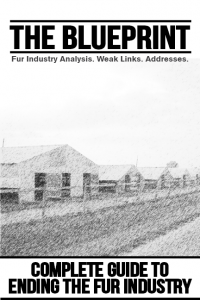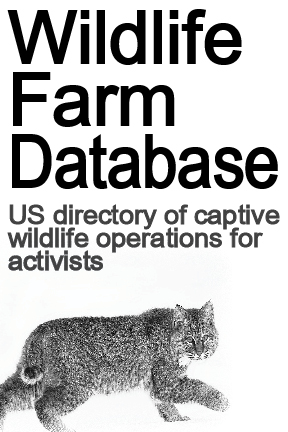The Final Nail has posted a newly discovered fox farm in Illinois. Tim & Kim Allaman Southeast corner of Illinois State Route 164 and Illinois State Route 94 Rozetta, IL 61469 Notes: Fox farm.
Recent Posts
Address for possible Texas fox farm
The following address was obtained from public records, indicating a farm (or other type of operation) that imprisons gray fox and raccoons. Coalition Against Fur Farms has obtained hundreds of similar addresses from numerous states, each of which may be fur farms, which will be posted in the coming weeks. We will offer the same disclaimer each time: These addresses are uninvestigated. They house animals commonly used for fur, however an investigation is needed to determine the exact purpose of these operations. There are numerous other reasons furbearing animals can be held captive, including being bred for pets, roadside zoos, urine-collection operations for trapping lures, or penning operations to train hunting dogs. Some of these may be facilities which are helping animals. For example, wildlife rehabilitators and sanctuaries can often be required to have the same licenses as fur farms. Please do your research, and share anything learned with Coalition Against Fur Farms. The Texas address we obtained is: Deborah Schwartzkopf 5003 48th Street Lubbock TX Notes: Grey fox +...
Fur Industry “Communication Plan” Obtained by FinalNail.com
The online fur farm list Final Nail has obtained an internal fur industry document titled “A Communications Plan for the North American Fur Industry.” The document is based on a focus group that was aimed to determine public opinions about fur. We will offer Final Nail’s synopsis of the document (its a big one, at 101 pages), as it summarizes the takeaways well: The results are encouraging and a reminder of the power of the animal rights movement to shape public opinion: – Only one-in-five Americans (and 14% of women) think that trapping is conducted humanely. – Only one-quarter of Americans (19% of women) believe that mink and other animals on fur farms are raised humanely. – One-third of women (33%) cite “concerns about animals” as their reason for not wearing fur. The opinion poll was followed with a focus group conducted in New York City in March 2012. The group discussion revealed, “discomfort about wearing fur related to industry practices.” When presented with images of fur garments, focus group members reacted with feelings of warmth and luxury, but the images also suggested “animal death and cruelty.” It was clear that animal rights messages about fur, “have become part of society’s collective consciousness.” Communication Plan for the Fur...
More new addresses: Over 300 possible fur farms in Illinois
Coalition Against fur Farms has obtained a spreadsheet containing every “furbearning animal breeder” in the state of Illinois for the year 2012. This file contains 301 addresses, which are posted below. Alternately, you can download the original Excel file (list also includes over 1,500 “game breeders” and other wildlife farms: Illinois Wildlife Breeders 2012 (download entire file) What is the “furbearing animal breeder” list? Unfortunately, the list does not denote the species held at each farm, which would help in determining what type of operation each of these are (note: Coalition Against Fur Farms does not support keeping any animal captive, but for the purpose of furthering our mission statement, we attempt to identify businesses that are specifically involved in the fur industry). Here’s what we do know, from the Illinois Department of Natural Resourced (DNR): “[A] Fur Bearing Animal Breeder [license] is required to possess, breed and/or sell the following species: Opossum, Raccoon, Mink, Red & Gray Fox, Beaver, Muskrat, Badger, River Otter and Weasels” The most common animals raised for fur are mink and fox, which are included in the above list. So, in theory all mink and fox farms in the state are included here. However it’s worth noting that a quick search through this list for all farms posted on FinalNail.com shows that only abou1/3 of them are included. Because the addresses on FinaNail can be expected to be (for the most part) current, it raises the question: Why aren’t all farms on this list? The answer, very likely, is that many fur farms are simply operating illegally. It is extremely unlikely there are over 300 fur farms operating in Illinois, and this list is likely to include a spectrum of businesses. We encourage anyone who lives near any of these addresses to drive by and tell us what you see. CAFF is very interested in knowing which of these are in fact fur farms. Here’s the list (formatting imperfect because of the Excel source file): POTTER EDWARD R R 1 BOX 119 PATOKA 62875 GOODING EDWARD 1810 E 1650TH ST PALOMA 62359 DAVIS QUINCY 6931 S PERRY CHICAGO 60621 WEBER TAMMY 617 N 600 E RD BUCKLEY 60915...
Illinois Fur Farmer Dies, Farm Reported Closed
According to the fur trade publication Sandy Parker Reports, Charles K. Ide (Downers Grove, IL) died in October, and “…he pelted out in 1997 and retired.” “Pelted out” refers to the killing every animal on a farm and shutting it down. If you have any information that conflicts with this report, please send to...
United Vaccines Facility Expands: View the Building Plans
The crucial fur farm vaccine supplier United Vaccines, based just ouside Madison WI (the US’s largest fur farming state), is undergoing an expansion. We are posting below the paperwork filed with the city of Fitchburg, detailing the expansion and revealing some interesting information, such as: 1) The size and location of the proposed expansion. 2) The email address and cell phone number of the United Vaccines contact person. 3) The number of employees at this United Vaccines facility (there are reportedly two other UV locations near Madison): 39 presently, and 46 after the expansion. United Vaccine Building...
Idaho Couple May Lose Home Over Mink Farm
According to a story this week in the Idaho State Journal, a couple in Idaho may be forced to lose their home over the Ball Brothers mink farm. “They moved in on us and they have more or less bankrupted us”. In 2007, construction began on the farm, after the Ball brothers made plans to move their fur farm from Morgan, Utah to Malad, Idaho. The farm is estimated to imprison 20,000 mink. Neighbors of the farm fought in court to block the construction of the farm, but ultimately lost. Now two of the neighbors – Bob and Bev Reudter – have had their hours devalued to the point they move lose the property. The couple says that because of the smell of the mink farm, family no longer visits them and friends will not come over. The couple says they can’t cook outside because of the smell and number of flies. “We have flies, not by the hundreds, but by the thousands,” Bev said. “You wake up in the morning and you have to kill flies. You start breakfast, you have to make sure the flies stay off of the breakfast. You leave even a cereal bowl down and it’s (quickly) full of flies.” The Reudter’s gave this admonishment to anyone in a neighborhood where a fur farm might move in: “We just want people to be aware that if they get news there is a mink farm going to go in, to fight, fight, fight, because it’s awful. It’s dropped our quality of life to almost nothing.” This is the full article: MALAD — When a mink farm sought to locate on property adjacent to Bob and Bev Reudter’s rural Malad home five years ago, they and several of their neighbors fought against it to no avail. After nearly five years of living next to the mink farm, which Bev says has robbed the couple of any quality of life, the Reudters are also in a dire financial situation they currently see no escape from. “They moved in on us and they have more or less bankrupted us,” Bev said. “There is $3,000 between us and nothing. Our financial situation is $3,000....
Science Journal Concludes Mink on Fur Farms Suffer
The reputed science journal Nature published a 2001 article on the suffering of fur farmed mink. The article concludes that mink kept in cages suffer from lack of access to water the same way they suffer from lack of access to other necessities, such as food. Some quotes from the article: “Our results indicate that fur-farmed mink are still motivated to perform the same activities as their wild counterparts, despite being bred in captivity for 70 generations”. “…in the wild (mink) would patrol territories 1–4 km long, use several nest sites, and hunt by following scent trails, investigating burrows, and diving and swimming for aquatic prey.” “The high level of stress experienced by mink denied access to the pool, rated as the most valuable resource, is evidenced by an increase in cortisol production indistinguishable from that caused by food deprivation. These results suggest that caging mink on fur farms does cause the animals frustration, mainly because they are prevented from swimming.” Despite arguments that mink housed in fur farms have successfully adapted to captivity, these animals may suffer by being deprived of resources that exist in the wild.” Frustrations of Fur-farmed...






